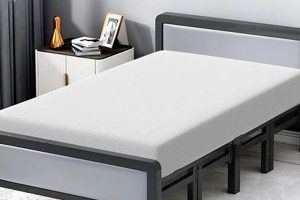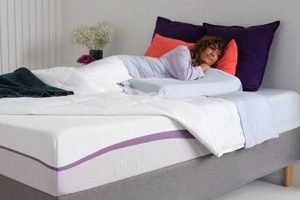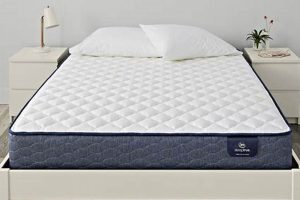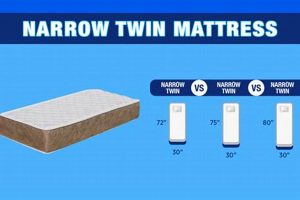A sleeping surface designed for a single occupant, typically measuring around 38 inches wide and 75 inches long, manufactured by Naturepedic. These products differentiate themselves through the use of certified organic materials in their construction, aiming to minimize exposure to synthetic chemicals and allergens during sleep. The company emphasizes natural latex, organic cotton, and other eco-friendly components in lieu of polyurethane foam and chemical flame retardants commonly found in conventional mattresses.
The appeal of such a product lies in its potential health benefits and environmental responsibility. By avoiding synthetic materials, these mattresses may reduce the risk of off-gassing and allergic reactions, offering a safer sleep environment, particularly for children and individuals with sensitivities. Furthermore, the use of organically sourced materials supports sustainable agricultural practices and reduces reliance on petroleum-based products, contributing to a smaller environmental footprint. The growing awareness of chemical sensitivities and the desire for eco-conscious living has fueled the demand for these specialized bedding solutions.
Subsequent sections will delve into the specific materials employed, construction techniques utilized, certifications obtained, and consumer considerations relevant when evaluating organic sleeping surfaces designed for smaller beds. It also explores alternative products that offer similar advantages.
Considerations for Selecting an Organic Twin Bed
Choosing a sleeping surface constructed from organic materials requires careful evaluation to ensure it meets individual needs and expectations. Due diligence regarding material sourcing, construction methods, and third-party certifications is essential.
Tip 1: Prioritize Certified Organic Materials: Verify that the cotton, latex, and wool used in the mattress are certified organic by a reputable organization such as GOTS (Global Organic Textile Standard) or GOLS (Global Organic Latex Standard). These certifications ensure that the materials meet stringent environmental and social criteria throughout the production process.
Tip 2: Inquire About Flame Retardants: Conventional mattresses often contain chemical flame retardants that can pose health risks. Confirm that the mattress meets fire safety standards without the use of such chemicals. Look for alternatives such as wool, which is a natural flame retardant.
Tip 3: Assess Firmness and Support: Consider the sleeper’s weight, sleeping position, and any existing back or joint issues when selecting the firmness level. Proper spinal alignment is crucial for comfortable and restful sleep.
Tip 4: Evaluate Airflow and Breathability: Organic mattresses made with natural materials like cotton and latex tend to be more breathable than those made with synthetic foams. Proper airflow helps regulate body temperature and prevent overheating during sleep.
Tip 5: Research Construction and Durability: The construction method and quality of materials directly impact the mattress’s longevity. Look for durable stitching, reinforced edges, and a well-constructed core to ensure years of reliable use.
Tip 6: Review Warranty and Return Policies: A comprehensive warranty and a generous return policy offer peace of mind. Be sure to understand the terms and conditions before making a purchase.
Tip 7: Compare Prices and Read Reviews: Research and compare prices from various retailers. Read reviews from other consumers to gain insights into the mattress’s performance, comfort, and durability.
Selecting a twin bed made from organic materials represents a commitment to both personal health and environmental sustainability. Careful consideration of the factors outlined above will aid in making an informed decision.
Further investigation into specific brands and models will provide a more detailed understanding of the available options and their respective features.
1. Organic Certified Materials
Organic certification of materials is a foundational aspect of the products from Naturepedic, reflecting a commitment to environmentally responsible and health-conscious manufacturing. This certification assures consumers that the raw materials used in its twin mattress meet specific standards, verified by independent third-party organizations, regarding agricultural practices and processing methods.
- GOTS (Global Organic Textile Standard) Compliance
GOTS certification ensures that the cotton and other textiles used in the mattress meet rigorous environmental and social criteria throughout the entire supply chain, from harvesting to processing to manufacturing. This includes restrictions on the use of pesticides, dyes, and other chemicals, as well as adherence to fair labor practices. For the mattress, GOTS certification signifies a reduced exposure to potentially harmful substances, and it affirms the ethical sourcing of materials.
- GOLS (Global Organic Latex Standard) Compliance
For mattresses incorporating latex, GOLS certification provides assurance that the latex is derived from organically managed rubber tree plantations. The standard addresses the entire latex production process, including harvesting, processing, and manufacturing, ensuring that it is produced in an environmentally and socially responsible manner. GOLS also sets limits for harmful substances and emissions.
- Reduced Chemical Exposure
The use of certified organic materials inherently reduces the consumer’s exposure to potentially harmful chemicals commonly found in conventionally produced mattresses, such as flame retardants, polyurethane foam, and volatile organic compounds (VOCs). This reduction in chemical exposure can be particularly beneficial for individuals with sensitivities, allergies, or concerns about the long-term health effects of chemical exposure.
- Environmental Stewardship
The adoption of organic agricultural practices and the avoidance of synthetic materials in the production of mattresses contribute to environmental stewardship. Organic farming methods promote soil health, conserve water, and reduce reliance on synthetic pesticides and fertilizers. Furthermore, the use of natural materials such as organic cotton and latex reduces the demand for petroleum-based products, minimizing the carbon footprint associated with mattress manufacturing.
Therefore, “Organic certified materials” isn’t just a label; it represents a holistic approach to manufacturing, considering the interconnectedness of human health, environmental sustainability, and ethical sourcing. Such certifications offer consumers with the assurance of the mattress’s safety and its alignment with broader environmental values.
2. Hypoallergenic Construction
Hypoallergenic construction constitutes a significant feature in Naturepedic twin mattresses, designed to minimize the risk of allergic reactions in sensitive individuals. This approach encompasses the selection of materials and manufacturing processes that mitigate potential allergens, promoting a healthier sleep environment.
- Elimination of Common Allergens
Naturepedic twin mattresses specifically exclude materials known to be common allergens, such as polyurethane foam, which can harbor dust mites and release volatile organic compounds (VOCs). The absence of these substances reduces the likelihood of respiratory irritation and allergic responses in susceptible individuals.
- Encapsulation of Potential Allergens
Where potential allergens, such as latex, are utilized, they are typically encased in layers of certified organic cotton or other barrier fabrics. This encapsulation minimizes direct contact with the sleeper, preventing the release of allergenic proteins into the sleep environment. The design strategy confines potential allergens to the mattress core.
- Dust Mite Resistance
The dense structure and natural properties of materials like organic cotton and wool contribute to dust mite resistance. Dust mites, a common allergen, thrive in warm, humid environments with ample food sources (dead skin cells). The use of tightly woven fabrics and moisture-wicking materials reduces the prevalence of these organisms within the mattress.
- Mold and Mildew Resistance
The materials used in Naturepedic twin mattresses are selected for their resistance to mold and mildew growth. Natural latex, for example, possesses inherent antimicrobial properties, inhibiting the proliferation of these microorganisms. Maintaining a dry and well-ventilated sleep environment further minimizes the risk of mold and mildew accumulation.
The commitment to hypoallergenic construction in Naturepedic twin mattresses reflects a proactive approach to mitigating potential health risks associated with allergens in bedding. By carefully selecting materials and employing design strategies that minimize allergen exposure, these mattresses offer a safer and more comfortable sleep experience for individuals prone to allergies and sensitivities.
3. Non-toxic composition
The non-toxic composition of the Naturepedic twin mattress is a direct consequence of its design philosophy, which prioritizes the elimination of harmful chemicals and synthetic materials commonly found in conventional bedding. This commitment stems from growing awareness of potential health risks associated with prolonged exposure to such substances, particularly for vulnerable populations like children. The cause is the desire for a safer sleep environment; the effect is a mattress constructed without polyurethane foam, chemical flame retardants, vinyl, phthalates, and other potentially harmful substances. This composition is not merely a marketing claim, but a fundamental component that defines the product’s value proposition and aligns with the principles of preventative health.
An illustrative example of the practical significance of this non-toxic composition can be seen in the case of individuals with Multiple Chemical Sensitivity (MCS). These individuals exhibit heightened sensitivity to a wide range of chemicals, and exposure to even trace amounts can trigger adverse reactions. A mattress with a non-toxic composition, such as the Naturepedic twin, can provide a safe haven, minimizing exposure to potential triggers and promoting restful sleep. Furthermore, the use of certified organic cotton and latex reduces the risk of off-gassing, the release of volatile organic compounds (VOCs) that can contribute to indoor air pollution and respiratory problems. The absence of chemical flame retardants, often replaced by natural alternatives like wool, eliminates a significant source of potential endocrine disruptors. This focus on purity extends to the adhesives used in construction, ensuring that even these components are free from harmful chemicals.
In summary, the non-toxic composition of the Naturepedic twin mattress represents a proactive approach to minimizing chemical exposure and promoting a healthier sleep environment. While challenges remain in ensuring complete elimination of all potential toxins and verifying the long-term health impacts of specific materials, the company’s commitment to transparency and third-party certifications provides a measure of assurance. The broader implications extend beyond individual health, contributing to the development of more sustainable and responsible manufacturing practices within the bedding industry.
4. Firmness options available
The availability of various firmness levels in a Naturepedic twin mattress directly addresses the diverse needs and preferences of individual sleepers. Firmness, defined as the degree of resistance to compression, significantly impacts spinal alignment, pressure point relief, and overall sleep comfort. Considering a twin mattress is typically intended for children, teenagers, or single adults, the range of firmness options becomes particularly relevant. For example, a lightweight child or teenager may find a softer mattress more comfortable, allowing for proper spinal curvature and pressure distribution. Conversely, a heavier individual or someone with back pain may require a firmer surface to maintain spinal alignment and prevent excessive sinking. This availability ensures the sleeping surface can be tailored to individual physiological needs, maximizing restorative sleep.
The inclusion of multiple firmness options is not merely a matter of comfort; it also addresses therapeutic concerns. Individuals recovering from injuries or managing chronic pain conditions may require specific levels of support to facilitate healing and minimize discomfort. A too-soft mattress can exacerbate back pain, while a too-firm mattress can create pressure points and disrupt circulation. Offering various firmness allows for targeted support, accommodating diverse health requirements. Furthermore, practical application of this understanding is vital for retailers and healthcare professionals. Recommending a suitable firmness level based on individual assessment enhances customer satisfaction and contributes to improved health outcomes. Detailed product specifications, including firmness ratings and recommended weight ranges, are essential for informed decision-making.
In conclusion, the availability of firmness options is an integral component of the Naturepedic twin mattress, reflecting a commitment to personalized sleep solutions. While challenges may arise in accurately assessing individual firmness preferences and ensuring consistent firmness levels across different mattress models, the benefits of tailored support outweigh these challenges. This emphasis on individual needs aligns with the broader theme of health-conscious and customer-centric product design, solidifying the mattress’s position as a versatile and adaptable bedding solution.
5. Durable, lasting support
The co
ncept of durable, lasting support is inextricably linked to the value proposition of a Naturepedic twin mattress. The construction and materials employed are intentionally selected to provide consistent support over an extended lifespan. This isn’t merely an aesthetic consideration; it’s a functional imperative. A mattress lacking durability compromises spinal alignment, leading to discomfort, disrupted sleep, and potential long-term musculoskeletal issues. The use of high-density organic cotton batting and natural latex core, for example, directly contributes to the mattress’s ability to withstand compression and maintain its structural integrity over time. This contrasts sharply with conventional mattresses that often utilize lower-density polyurethane foam, which degrades more rapidly, resulting in sagging and diminished support. The cause is the commitment to quality materials; the effect is a mattress capable of delivering consistent support for years.
The importance of durable support is further underscored by the intended use cases of a twin mattress. Often used by children and adolescents, a durable and supportive mattress is crucial for proper skeletal development. Poor support during these formative years can contribute to postural problems and chronic pain later in life. Real-life examples demonstrate the significance: a child with scoliosis requiring consistent spinal alignment benefits immensely from the firm, unwavering support of a well-constructed mattress. Similarly, an athlete using a twin mattress in a dorm room needs a surface capable of withstanding nightly use and providing adequate support for muscle recovery. The practical significance of this understanding extends to consumer purchasing decisions. The price point may be higher than conventional alternatives, but the long-term benefits of durability and support far outweigh the initial investment. A longer lifespan translates to reduced replacement costs and, more importantly, improved health outcomes.
In conclusion, durable, lasting support is not simply a feature of a Naturepedic twin mattress; it is a core characteristic that defines its value and differentiates it from conventional alternatives. The materials, construction, and intended use all converge to emphasize the importance of consistent, reliable support. While assessing durability can be challenging without long-term testing, the company’s commitment to quality materials and construction provides a measure of assurance. This emphasis on durability aligns with the broader theme of sustainable consumption, promoting products designed to last, reducing waste, and minimizing environmental impact.
6. Breathable fabric cover
The inclusion of a breathable fabric cover on a Naturepedic twin mattress serves a critical function in regulating temperature and managing moisture within the sleep environment. This cover, typically crafted from organic cotton, allows for improved air circulation compared to synthetic alternatives. The breathability mitigates heat buildup during sleep, reducing the likelihood of overheating and promoting a more consistent body temperature throughout the night. The cause being organic cotton, the effect is breathability. Moreover, the fabric’s ability to wick away moisture contributes to a drier sleep surface, inhibiting the growth of mold and dust mites, thereby enhancing overall hygiene and promoting a more allergen-free environment. This is particularly relevant for children, who are more susceptible to temperature fluctuations and may experience discomfort or restlessness due to excessive heat.
The practical significance of a breathable cover is evident in cases of individuals residing in warmer climates or those prone to night sweats. The cover facilitates the evaporation of moisture, preventing it from becoming trapped within the mattress core. Trapped moisture can lead to the degradation of materials and the proliferation of microorganisms. By maintaining a drier sleep surface, the breathable cover contributes to the longevity of the mattress and reduces the risk of skin irritation or respiratory issues. The choice of organic cotton further enhances the benefits, as it avoids the use of chemical finishes that can diminish breathability and introduce potentially harmful substances into the sleep environment.
In summary, the breathable fabric cover on a Naturepedic twin mattress is not merely an aesthetic feature; it is a functional component that plays a vital role in temperature regulation, moisture management, and overall sleep comfort. While challenges remain in quantifying the precise degree of breathability and its impact on individual sleep quality, the principles of thermodynamics and textile science support its beneficial effects. The selection of organic cotton reinforces the company’s commitment to non-toxic materials and sustainable manufacturing practices, aligning with the broader goal of promoting healthier and more environmentally responsible sleep solutions.
7. Fire safety compliance
Fire safety compliance is a critical aspect of mattress manufacturing, particularly for products like the Naturepedic twin mattress, which cater to a health-conscious consumer base. Strict regulations are in place to mitigate fire hazards associated with bedding, and manufacturers must adhere to these standards to ensure consumer safety. This necessitates a balance between fire protection and the use of non-toxic materials, presenting a unique challenge for producers of organic mattresses.
- 16 CFR Part 1633: Open Flame Standard
This federal regulation, also known as the open flame standard, mandates that mattresses withstand a 30-minute open flame test. The test simulates a bed fire scenario to assess the mattress’s flammability. Manufacturers, including Naturepedic, must design their mattresses to meet this standard, typically by incorporating flame-resistant barriers. In the context of organic mattresses, this often involves using natural materials like wool, which possesses inherent flame-resistant properties, rather than relying on chemical flame retardants.
- 16 CFR Part 1632: Cigarette Ignition Resistance
This standard, also known as the cigarette ignition resistance test, requires mattresses to resist ignition from a lit cigarette. This test assesses the mattress’s ability to prevent a smoldering fire. Naturepedic, along with other manufacturers, must ensure their mattresses pass this test to comply with federal regulations. This often involves using tightly woven fabrics and strategically layering materials to minimize the risk of ignition.
- Material Selection and Non-Toxic Alternatives
Achieving fire safety compliance while maintaining a non-toxic composition is a primary challenge for organic mattress manufacturers. Traditional chemical flame retardants, such as polybrominated diphenyl ethers (PBDEs), have been linked to health concerns. Therefore, companies like Naturepedic prioritize the use of natural alternatives, such as wool, which acts as a natural fire barrier without releasing harmful chemicals. This material choice necessitates careful consideration of fabric density, layering techniques, and overall mattress construction to ensure effective fire protection.
- Third-Party Certifications and Verification
To provide assurance to consumers, manufacturers often seek third-party certifications to verify fire safety compliance and material
safety. Organizations like UL (Underwriters Laboratories) conduct independent testing and certification to confirm that mattresses meet applicable fire safety standards. These certifications provide an additional layer of verification and transparency, allowing consumers to make informed purchasing decisions. For Naturepedic twin mattresses, such certifications demonstrate a commitment to both safety and environmental responsibility.
The intersection of fire safety compliance and the use of natural materials in the Naturepedic twin mattress highlights the ongoing effort to balance consumer safety with environmental and health considerations. While strict regulations mandate fire protection, manufacturers are increasingly adopting innovative approaches and utilizing natural materials to minimize the use of potentially harmful chemicals. This commitment reflects a broader trend towards sustainable and health-conscious product design within the bedding industry.
Frequently Asked Questions
This section addresses common inquiries and concerns regarding the selection, use, and care of a Naturepedic twin mattress. Information presented aims to provide clarity and assist in making informed decisions.
Question 1: What materials constitute the construction of a Naturepedic twin mattress?
Naturepedic twin mattresses are typically constructed using certified organic cotton fabric, batting, and fill. Some models incorporate organic latex derived from rubber trees, and a fire barrier of organic wool may be included. The specific materials and their proportions vary depending on the model.
Question 2: Are Naturepedic twin mattresses treated with chemical flame retardants?
No. Naturepedic twin mattresses are designed to meet federal fire safety standards without the use of chemical flame retardants. Instead, materials like organic wool, which possesses natural flame-resistant properties, are employed.
Question 3: How does the firmness of a Naturepedic twin mattress compare to conventional mattresses?
Firmness varies across different Naturepedic twin mattress models. Some are designed to be firmer, providing more support for spinal alignment, while others offer a plusher feel. Consumers should consult product specifications to determine the firmness level that best suits their individual needs and preferences.
Question 4: What certifications should one look for when purchasing a Naturepedic twin mattress?
Key certifications include GOTS (Global Organic Textile Standard) for organic textiles and GOLS (Global Organic Latex Standard) for organic latex. These certifications verify that the materials meet stringent environmental and social criteria throughout the production process. Certifications for fire safety compliance are also relevant.
Question 5: How should a Naturepedic twin mattress be cleaned and maintained?
Spot cleaning with a mild, non-toxic detergent is recommended for spills or stains. Avoid using harsh chemicals or excessive moisture. A mattress protector can help prevent stains and prolong the life of the mattress. Regular rotation of the mattress can promote even wear.
Question 6: What is the expected lifespan of a Naturepedic twin mattress?
The lifespan of a Naturepedic twin mattress depends on factors such as usage, care, and the specific model. However, due to the use of high-quality, durable materials, these mattresses are generally expected to last longer than conventional mattresses. A comprehensive warranty provides assurance of product quality and longevity.
In summary, a Naturepedic twin mattress offers a sleep surface constructed from certified organic materials, free from chemical flame retardants, and designed for both comfort and durability. Proper maintenance and consideration of individual needs are essential for maximizing its benefits.
The following section will delve into the environmental impact and sustainability practices associated with the production and disposal of these mattresses.
Conclusion
The preceding analysis has explored various facets of the naturepedic twin mattress, emphasizing its construction from certified organic materials, adherence to fire safety standards without chemical retardants, and the provision of durable and hypoallergenic sleep surfaces. The discussion encompassed firmness options, breathability considerations, and relevant certifications. These aspects collectively define the product’s value proposition, emphasizing health, safety, and environmental responsibility.
The continued demand for bedding solutions that minimize chemical exposure and prioritize sustainable practices suggests a sustained relevance for the naturepedic twin mattress in the marketplace. Prospective buyers should carefully evaluate individual needs, consider certified product specifications, and assess the long-term health and environmental implications before making a purchase. Further research into evolving materials and manufacturing processes within the organic bedding industry is recommended to remain informed about the latest advancements in this field.


![Best Adjustable Mattress Twin Size [Guide 2024] Organic & Natural Mattress Buyer’s Guide: Non-Toxic Sleep Solutions Best Adjustable Mattress Twin Size [Guide 2024] | Organic & Natural Mattress Buyer’s Guide: Non-Toxic Sleep Solutions](https://mattressworldpa.com/wp-content/uploads/2025/07/th-5087-300x200.jpg)


![Best Twin Daybed Mattress [Guide & Deals] Organic & Natural Mattress Buyer’s Guide: Non-Toxic Sleep Solutions Best Twin Daybed Mattress [Guide & Deals] | Organic & Natural Mattress Buyer’s Guide: Non-Toxic Sleep Solutions](https://mattressworldpa.com/wp-content/uploads/2025/07/th-5084-300x200.jpg)

